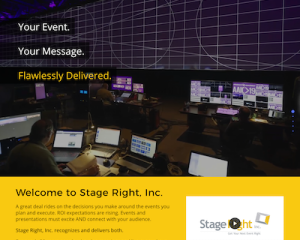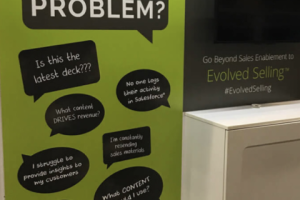
What’s wrong with my marketing? It’s a good and objective question to ask yourself periodically. It could very well uncover issues that need addressing. Here’s an example.
Before starting Element-R Partners, I represented several large corporations on behalf of a national PR firm.
Pre-Internet, when trade shows were one of the best ways to reach new buyers, I walked into a client’s booth and got a shock: the product manager was angry. “Where’s my announcement?”
The company was developing a new division, along with a new name, new products, and new services.
“We weren’t ready to launch,” I calmly answered.
The marketing manager — my direct contact — was quite nervous (not that I wasn’t, but I stuck with my guns).
There was much that needed to be figured out before launch. Namely, the entire effort!
Once we did do the right preparation, the launch of their new division (at yes, another trade show) was a big success: it was creative, compelling, and attracted a lot of attention. The product manager did in fact come to appreciate why we waited to be truly ready to launch.
The moral: don’t just do ‘stuff.’ Preparation is key.
This is one example of the many ways I have seen companies go about their marketing in the wrong way.
As business owners, sales or product managers, we all want our marketing to get done fast — and of course, to work. But you can’t just pull the right marketing answers out of thin air. You must figure out the what’s, why’s and how’s. There is no silver bullet!
Preparation, perspective on strategy and decisions on exactly how to execute impact results.
Here are the key mistakes I’ve seen, and how you can avoid them.
It’s a fact: 88% of companies talk mainly about their company, product or service (Forrester Research).
If you ever sit down and write: ‘(My company) is _________.’ ‘ We are _______.’
STOP! No one cares who you are. They only care about what you can do for them.
This is nothing new for experienced marketers, and for business owners who are likely also the primary salesperson. In sales we all know to ask questions, identify the buyer’s pain, then speak directly to it.
But what happens to a lot of us when we write anything about our business, whether it be a sales presentation, our website, an email, and so on? We stiffen up and get formal. We want to toot our own horn first, just to make sure they hear it ALL.
That’s guaranteed to suck all the air (and the potential interest) out of your effort.
Admittedly, it’s hard to take the what’s in it for me or outside-in perspective.
And harder still to define our real value to customers, then capture it in our marketing.
A good way to easily recognize this: Think about yourself and where you spend your time. What captures your attention?
E.g.: Our company has been in business for 15 years and we supply X, Y, Z. Vs: Find your competitive advantage here.
We solve your biggest (and smallest) accounting problem.
You know this intuitively. When a company speaks to you in YOUR language — not theirs — you are more apt to listen.
Some questions to ponder:
Many companies don’t really know their customers deeply enough, so their marketing is all about themselves.
Common marketing mistakes here:
How do you turn this around? Specifically, what can you do tomorrow?
And so on. You get the idea.
If you’re ambitious, you could also ask people who didn’t buy what the reasons were.
The answers to these may be surprising and often will tell you something new. Not just new, but REAL inputs on why they buy.
Next, capture your own thoughts and those of your team on the same questions. Then, take these inputs and use them to re-create your sales and content messages, from the customer’s perspective.
Here’s another useful exercise to brainstorm around:
The unique selling proposition, value proposition, dominant selling idea or whatever trendy name you want to give it: What makes your offering different, better?
Think about your elevator pitch or any basic company descriptor that you use a lot.
Your personal evangelism, philosophy and perspectives can also be of great value in shaping your differentiators. Think about soft values too: what are you selling that is not implicit to the product or service, but is a more human result, such as trust, knowledge, confidence, etc.?
Here’s where customer input comes directly into play. Use the work you did to understand the customer to strengthen or recast your differentiators.
Study your competitors for how they talk to customers to ensure you don’t sound the same. If you have any progressive competitors, you may just get some new ideas! But more likely you’ll find similarities and a lot of generic descriptions like ‘quality service’ ‘experienced’ etc. Avoid anything generic or that could be said by any company in your space. Be as specific as possible with your differentiators.
Create specific answers to different pain points that quickly and directly showcase your value and differentiation.
Yes, differentiating is hard if it’s not immediately obvious, especially in crowded fields. There’s certainly a science and art to teasing these out (having an agency partner or skilled communicator lead the effort can be a big help).
Then, use these differentiators to expand and develop campaign ideas, themes or topics for:
From your website Home page to your social media posts, your content MUST stop buyers from scrolling away.
So many mistakes can be seen here:
How can you make your content interesting and valuable for the buyer?
Again, think about yourself. Why do you skip over content? It’s likely part subject matter and part writing style. This is where your buyer insights come in. If you write about buyer issues or from the buyer’s perspective, you have solved 90% of the challenge.
Some possible improvements you can make:
Your website
Re-evaluate how you present yourself, especially on your Home page (where attention is won or lost). Speak directly to buyer’s business and personal pains and aspirations. Show empathy — that you understand their problems. Position yourself as the right resource to solve their problems.
Your content isn’t planned, or is haphazard and intermittent
Like any other long-term commitment, you need a good content plan. It’s a matter of bringing together all the elements: target personas, their pain, what they care about when it comes to a service or product like yours, and finally your knowledge and how you can help. If you’ve done your preparation, you and your team should easily be able to brainstorm dozens of topics for new content.
Tie your content to the customer journey
On average, the B2B buyer journey involves consuming 17 pieces of content before making a choice of vendor. Once you have your personas, the next logical step is to break down the journey from the casual looker to the committed buyer. Your job with content is to inform every step of this process.
Do you ever feel you have too much to be doing when it comes to marketing?
That’s the beauty of starting with a well-thought-out strategy before the time comes to do the actual work. Some suggestions here:
Even a short-term (3-6 month) strategy will give you a sense of direction and purpose with your marketing effort, instead of ‘just getting it done’ or ‘doing what we’ve always done’ without enough thought behind it. And having a strategy with metrics enables you to evaluate and modify to improve results on the next round.
Avoiding these errors will almost certainly put you a step ahead of your competitors in how you present your company. With all the preparation you’ve done, especially the customer intel behind it, you just may find yourself inspired and excited about the possibilities.
What are some of most common marketing mistakes you’ve seen? Please comment and share your experience.
Susan Duensing, CBC is Co-Founder of Element-R Partners, LLC. This article is based on a presentation given at a NAWBO Chicago chapter event.

Demanding an innovative departure from predictable product introductions, USG tapped Element-R to help unveil new, patented technology.
We created a high impact event for industry leaders by an industry leader, using several non-traditional elements to make the launch distinctive:
The event achieved the objectives of generating excitement around the new technology while seeding long-term market interest among the 70+ guests from 35 companies. The majority of survey respondents rated the event as outstanding.

In the early days of personalized medicine, few people understood the new science of pharmacogenetics – how medicines interact with an individual’s genes, often causing avoidable side effects. YouScript software by Genelex (now owned by Invitae) was a pioneering technology giving physicians detailed input on these interactions for the benefit of patients.
To gain industry media attention for the relatively unknown company, Element-R recommended a purely educational webinar for the media only. Delivered entirely by an M.D., the webinar effectively informed editors and reporters about the topic – with a bonus: several covered the burgeoning science and the company’s leadership in feature-length articles.

All high-end professional AV and event staging companies show off their best events to attract prospects. Stage Right, Inc. needed to revitalize its digital doorstep and deliver key differentiators.
Element-R created a new, from the ground up website that made the company stand out on two fronts. First, instead of simply showing off glitz, we organized and showcased its capabilities by category, allowing prospects to identify and pair their challenges with a clear solution. Second, we branded and spotlighted the company’s proprietary planning protocols, now known as StageCraft™. Stage Right, Inc. has a modern, responsive site that places its distinctive competencies out front.

When the nation’s oldest senior living community in the U.S. needed to reinvigorate its marketing, Element-R Partners helped Three Crowns Park play to its strengths in a crowded marketplace.
Through a deep dive with residents and staff, we developed messaging that appealed to retirees who don’t want to live in a cold institution or ritzy resort/hotel setting. The new website faithfully presents this welcoming and close-knit community of friendship and relaxed, suburban style living.

To meet a changing world of special education with funding and competitive challenges, the O-School needed to reacquaint its many publics about the organization’s mission and capabilities.
Interviewing staff and multiple influencer groups, Element-R developed a “messaging playbook” that served as the basis for all aspects of its external communication to encourage student enrollment and support funding. The backbone of this effort were two new websites, www.oschool.org and www.bw-center.org, creating a cohesive presence for the School in all of its materials, and bringing it into the 21st Century.
 Go bold! Evolved Selling™ software maker Mediafly offers a sophisticated content management and sales enablement solution to organizations worldwide. To really make a statement at its channel partners’ annual conferences, Dreamforce and Sapphire, Mediafly nixed the typical descriptive booth copy, instead drawing visitors in with bold problem statements its audience could relate to.
Go bold! Evolved Selling™ software maker Mediafly offers a sophisticated content management and sales enablement solution to organizations worldwide. To really make a statement at its channel partners’ annual conferences, Dreamforce and Sapphire, Mediafly nixed the typical descriptive booth copy, instead drawing visitors in with bold problem statements its audience could relate to.
Together with design partner DoubleTake Design, Element-R developed channel partner messaging and several alternative creative concepts for the booth. We couldn’t have been happier that Mediafly selected this unusual and compelling way to present itself. Traffic was steady at the booths as visitors walked up to say, “can you really solve that problem for us?” The creative concept continues to be used successfully to bring attention to Mediafly’s many capabilities – proving that B2B marketing doesn’t have to be boring!